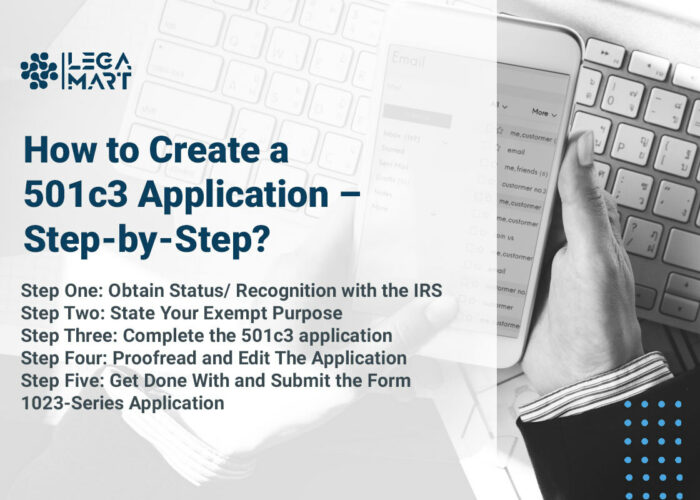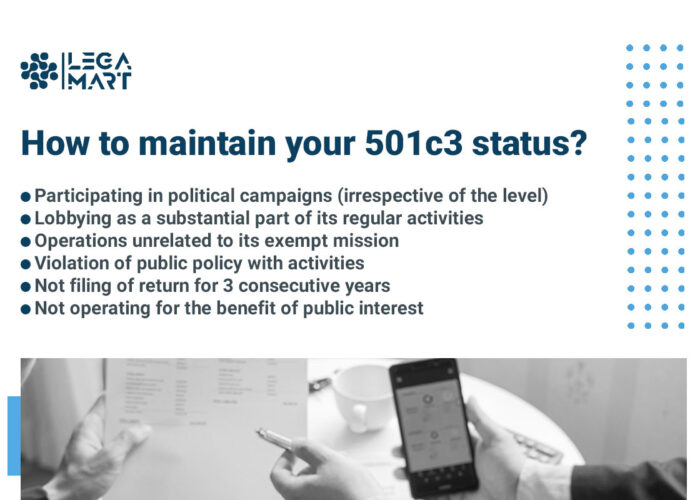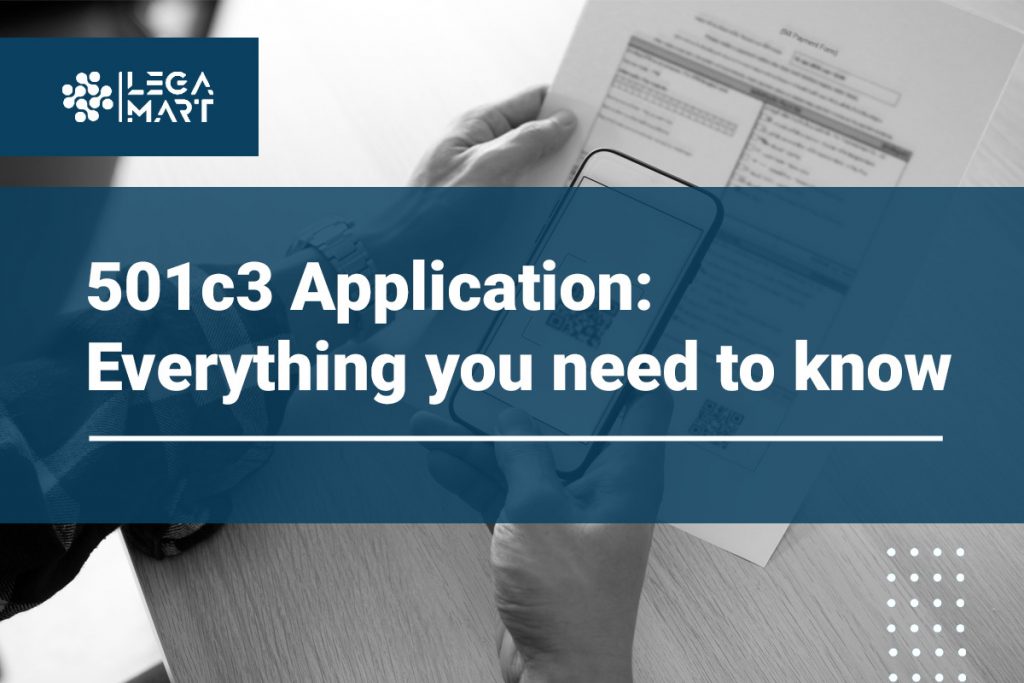Introduction
The obligation, or rather the burden of taxes, has been on the shoulders of humankind from the time since it started to formulate a more organised version of society. Over time, with the evolution of law into recognising organisations as separate legal entities from their owners, the ambit of taxes also evolved. In due course, individual humans were not the only ones required to pay taxes, but now this obligation is extended to organisations.
Even so, not all types of organisations are expected to pay taxes; hence, some have been spared from the duty of taxes. These are known as the Exempted Organisations under section 501 (c)(3) of the Internal Revenue Services (IRS) tax code. As stated above, the exempted organisations under section 501 (c)(3) are limited to ‘some’, meaning that those organisations must have certain traits to be recognised as exempted by the Internal Revenue Services. The process of such recognition is based on the 501 (c)(3) application filed by the organisation.
The Application process for exemption from taxes under section 501 (c)(3), of course, comes with its share of complexities and details that you otherwise may miss easily and may end up with failure on your part. That is why it is essential for you first to develop a proper understanding of the various aspects of the exemption501(c)(3) application that comes under the IRS tax code before you apply for it. To make your work easier, we at Legamart are here with everything you may need to know before starting your application.
So, without any more delays, let us get on with it!!
What is a 501c3 Application?
The advantages concerning paying taxes come in many forms, such as Deductions, Exemptions, or returns. In the United States, under the Internal Revenue Services tax code, certain organisations have been given exemption from paying taxes, but to get such advantages, an organisation must first appear as eligible before the IRS, for which it is needed to file a 501 (c)(3) application. A 501c3 application is a legal document that is required to be submitted to the Internal Revenue Service to qualify for tax exemptions by the Non-Organisations.
501c3 Application Process
As we said earlier, filing the 501c3 application can be complex if you don’t do your homework beforehand. Just like while filling out any other application, in the case of a 501c3 application, an organisation must first ensure its organisational paper is in place. That applies to all types of non-profit organisations, whether it is a trust or any other mentioned by the IRS.
After that, the organisation must have an Employer Identification Number before it files for exemption. A corporate entity is given a unique identifier known as an Employer Identification Number (EIN) so that the Internal Revenue Service(IRS) can quickly identify it. Employers frequently utilise EINs for tax reporting purposes. In case your organisation does not have an EIN yet.
The applicants are required two either of the two mentioned forms ( Namely the 1023 and 1023EZ) while making the 501c3 application for exempt status to the IRS. The IRS requires online applications for non-profit status. The procedure can be completed in as little as four weeks if an organisation is qualified to request non-profit exempt status using Form 1023-EZ. However, it may take up to six months or longer for individuals who need to submit Form 1023. The two forms mentioned by IRS have separate qualifications that an organisation must complete determining which form it can opt for.
Your organisation may come in as eligible for Form 1023EZ if it full fills the requirements mentioned below:
- The Gross income of the organisation is fifty thousand dollars for the last three years.
- The Gross Income Estimated for the next three years must also be under $50,000
- The Organisation (Non-profit) is having less than $250,000 in fair market assets
- The said organisation is formed in the United States with a domestic mailing address
- It is Organised as a corporation, unincorporated association, or Trust.
- The organisation must not be a successor to a for-profit entity.
Requirements for Form 1023 of the IRS
The Form 1023 of the IRS comes with other paperwork, and the process takes much longer to complete when you go for this form. Moreover, a failure to provide one or more of the items enlisted below may result in delays and may even lead to a total rejection of your 501c3 application.
- The checklist of form 1023
- The Application ( Form 1023 along with the applicable schedules A-H)
- The Articles of Incorporation or other organisational documents as stated by the IRS
- Any amendments (if any) to the organising documents. These should be provided in order of changes made.
- The bylaws of the organisation
- Attachments including financial data, printed materials, and explanations
- A check for a six-hundred dollar fee made payable to the department of treasury.
How to create a 501c3 application – Step-by-Step?

The essentials and procedure of filing the 501c3 application are not limited to just applying via forms 1023 and 1023EZ; those are only a part of the main operation. The process comes with many other requirements, especially if one starts from scratch and is new to the field. In the following section, we will discuss how to create a 501c3 application step by step to get exempt status.
The IRS has provided specific instructions to the people for using the provided information to complete the application for 501c3 status. Although the application process can be lengthy and time-consuming, you can save much time by staying organised and following this step-by-step process.
Step One: Obtain Status/ Recognition with the IRS
An organisation must be officially registered with the IRS under one of the following categories to be granted 501c3 status:
- Trust
- Corporation
- Association
Step Two: State Your Exempt Purpose
According to the IRS, each organisation must declare a specific exempt purpose to be eligible for 501c3 status. The official site of IRS states in relation to the exempt purpose that the charitable, religious, educational, scientific, literary, testing for public safety, supporting national or international amateur sports competition, and preventing cruelty to children or animals are among the exempt objectives listed in section 501(c)(3).
The term “charitable” is used in the legal sense that is generally accepted and includes helping the poor, the distressed, or the underprivileged, advancing religion, education, or science, building or maintaining public structures, monuments, or works, reducing the burdens of government, reducing tensions in the neighbourhood, eradicating prejudice, and discrimination, defending the human and civil rights guaranteed by law, as well as fighting community decay and juvenile delinquency.
Step Three: Complete the 501c3 application
Fill out Form 1023-Series of your 501c3 application so the IRS can review it. Please be sure to complete every field; if you need more space to respond to a question, continue your response on the document marked “supplemental information” attached. It’s also crucial to ensure you include all necessary supporting documents, such as financial reports, your organisation’s organisational documents, and any necessary power of attorney certifications.
Step Four: Proofread and Edit The Application
To ensure the success of your 501c3 application, do not forget to review it and make any necessary edits. The application must be completed accurately. Below are a few things/documentations you can check before moving ahead with the process.
- Ensure that5 the Organisation’s Employer Identification Number is Present in the proper place, i.e. Part 1, on page one of the application and every page of supplemental information.
- Ensure you have provided/attached the exact copies of the organisation’s organising documents.
- See that all applicable/relevant financial statements are in place.
- The information about the organisation’s power of attorney shall be provided (if applicable)
Step Five: Get done with and submit the form 1023-series application
As we said earlier, the key to obtaining 501c3 status with the IRS is to complete the Form-1023 Series application. The $275 user fee for organisations is to be included with the applicant’s completed, signed, and dated application. The user fee shall be paid to the United States Treasury by check or money order drawn in U.S. dollars.
Special considerations
Organisations meeting the 501c3 requirements can be divided into 2 categories – public charities and private foundations.
Public Charity
This is a non-profit organisation receiving a substantial portion of its income from either the government or the general public. Here, at least one-third of the income must be obtained through donations from the general public (including corporations, individuals, and non-profit organisations).
If an individual donates to a public charity (as considered by the IRS), they may qualify for certain tax deductions. Generally, the deductions are capped at 50% of their adjusted gross income (AGI). However, there is no cap on donations to charitable organisations coming under 501c3.
Private Foundation
These organisations are held by individuals, families, or corporations, and they obtain their income from a small group of donors. These are subjected to stricter rules and regulations than private charities. Generally, all 501c3 organisations are automatically classified to be private foundations unless they adequately prove that the IRS standards have been met for a public charity.
501c3 Organisation Requirements
Since the Internal Revenue Service thoroughly reviews all applications with a keen eye, it is essential for the applicants of 501c3 status to come in strong at certain mentioned requirements. The organisation information provided and other documentation must be accurate. The IRS views that to ensure that only eligible non-profits can benefit from the provided tax exemption under section 501c3.
Below is a simplified list of all the major requirements for filing a 501c3 application:
- The applicant organisation has to be a trust, corporation, or association formally registered with the IRS.
- The organisation’s exempt purpose must be acceptable to the IRS. Basically, it should be related to eligible purposes such as charitable, religious, or educational.
- The organisation needs to have an EIN, and if it doesn’t, it must request the same.
- Must provide the IRS with a full Form 1023-Series application, accompanying materials, and a user fee.
- Must submit an application within 27 months after the organisation’s founding date (the last day of the month after that).
- Must provide the public with free access to study the approved application, its supporting materials, and the prior three annual information returns.
How Long Does It Take for a 501c3 to be Approved?
The Federal Revenue Service (IRS) thoroughly examines each 501c3 application before approving it. Thus processing times vary greatly. The size and duration of an organisation, the length of the Form 1023-Series application, and even the number of non-profit applications currently pending at the IRS can all affect how long it takes for a 501c3 application to be accepted. Organisations should typically plan on waiting 3 to 12 months for approval. Moreover, the wait also depends on which of the two earlier-mentioned forms you filled (1023 or 1023EZ).
For example, the procedure can be completed in as little as four weeks if an organisation is qualified to request non-profit exempt status using Form 1023-EZ. However, it may take up to six months or longer for individuals who need to submit Form 1023. The eligibility criteria for each form we have discussed earlier in this discussion.
How to maintain your 501c3 status?

To maintain your 501c3 non-profit status, you are required to do annual filing. This may be done by Form 990, along with any other subsequent schedules accompanying it. There are four parts in IRS Form 990 – the first details the organisation’s mission and volunteer base, the second summarises revenue, the third summarises expenses, and the fourth summarises the net assets.
Along with the annual filing, the organisation is also expected to avoid being engaged in activities which can jeopardise the tax-exempt status of the organisation. These include:
- Participating in political campaigns (irrespective of the level)
- Lobbying as a substantial part of its regular activities
- Operations unrelated to its exempt mission
- Violation of public policy with activities
- Not filing of return for 3 consecutive years
- Not operating for the benefit of public interest
Further, the non-profit is expected to maintain minimum levels of unrelated activities, including activities for revenue generation, but not directly related to fundraising efforts.
Advantages and disadvantages of non-profit status
There are pros and cons attached to becoming a 501c3 non-profit.
Advantages
- Tax Advantage. The status allows non-profits to put more money into fulfilling their goals.
- Grant eligibility. There are many public and private grants that do not consider organisations not registered under 501c3.
- Formal structure. The existence of a formal structure helps in keeping founders and volunteers separate from the organisation. This, in turn, helps in the limited liability of the organisation away from founders, board of directors and volunteers until someone uses the organisation as a shield for their illegal actions.
Disadvantages
- Administrative work. Once you have been recognised as a non-profit, you are required to maintain detailed records for annual filings to the IRS.
- Shared control. According to the legal requirements in certain states, 501c3 non-profits are required to have several members on the board for the election of officers who determine the organisational policy.
- Public scrutiny. Considering that the existence of a non-profit is in the public interest, its accounts and records are reviewed by the public upon request. This is inclusive of salaries and expenditures.
Get Help with a 501c3 Application
If you plan on submitting your 501c3 application to the IRS and getting your non-profit an exempt status but still are not sure if you can do it on your own or not, or the process seems to be too lengthy and exhausting, and you don’t want to waste your time with all the complex details of the procedure. Well, in that case, you’ll be delighted to know that at legamart, you can get the right legal assistance and advice from the best of lawyers in the field of taxation, that too in a matter of minutes since you will be getting in touch with multiple attorneys and counsels via our online platform. What’s the hold-up now?
Frequently Asked Questions (FAQs)
How to check your 501c3 application status?
You can confirm your application status by calling the IRS at 877-829-5500. Provide the agent with your organisation’s legal name and EIN, post which the agent shall assist you with your application status.
What are the application fees to set up a 501c3?
If you file your non-profit’s articles of incorporation in your state, it can cost you about $100. The cost for IRS Form 1023 is $600. However, organisations having less than $50,000 as their annual earnings can file the 1023-EZ form by paying $275.




